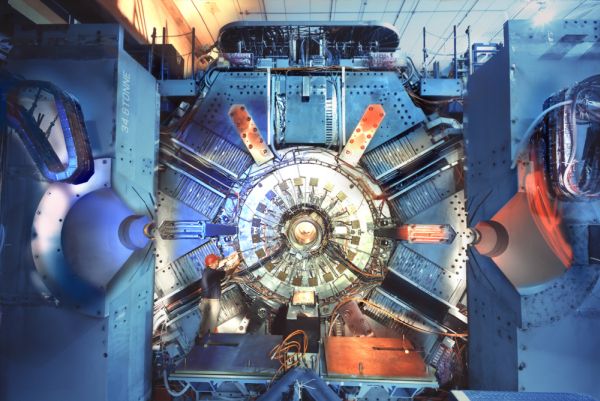BaBar Experiment Hints at Possible New Physics

The BaBar detector.
Courtesy of SLAC.
Experimental results are again clanging away at the Standard Model, the edifice on which physics of the very small is built. This time it is a careful analysis of particle decay data from the BaBar experiment, at the SLAC National Accelerator Laboratory in California. The inconsistencies were first observed in the Belle experiment in Japan five years ago. The two “B-factories” smash electrons and positrons together, creating an ample supply of particles called B-mesons, which are made of quarks and anti-quarks. While the collisions themselves have ended, researchers are actively analyzing several million gigabytes of data.
Over 300 scientists from the international collaboration analyzed the decay of the B-meson from the BaBar experiment at SLAC. Among other possibilities, it can decay into either a D-meson or an excited (higher-energy) D-meson, denoted as D-star, and a relatively heavy tau lepton and anti-neutrino. Other possibilities include decays in which the tau lepton is replaced by one of its lighter cousins: a muon or electron. Based on the Standard Model, theorists have a fair prediction of the abundance of such decays that involve a tau lepton relative to those involve a muon or an electron.
What the researchers found was that the decay into a tau lepton occurs more frequently than predicted by the Standard Model. The excess result was found to be statistically significant to 3.4 sigma, “not enough to claim observation of a non-Standard-Model effect, but an intriguing indication that this process deserves further study,” the SLAC researchers wrote to me in an email. The BaBar researchers may look to the Belle experiment for more data to corroborate the results.
Theoretically, the results could be suggestive of a charged Higgs particle, which is not part of the Standard Model. The idea is that the Higgs would skew the decays towards heavier particles—more tau leptons as observed. However, the BaBar researchers have already tested a simple model for the charged Higgs and concluded this simple model does not explain the findings. Meanwhile, as Wired Science reports, rumors of a Higgs particle announcement are starting up again.
Virat Markandeya is a contributor to Inside Science News Service.
